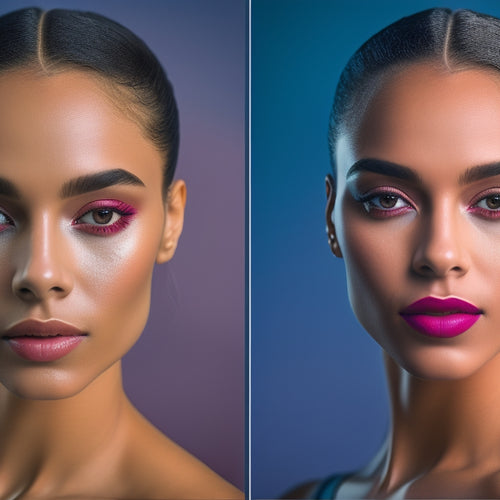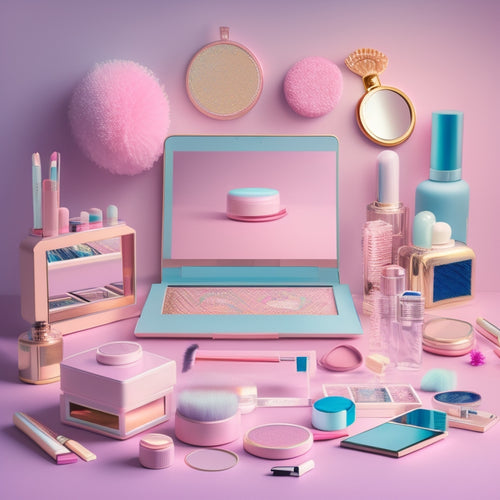
Do You Wear Barre Shoes or Barefoot?
Share
As you prepare for your barre workout, you're faced with an important decision: to wear barre shoes or go barefoot. Both options have their perks! Wearing shoes provides precision, control, and support for challenging movements, while going barefoot strengthens foot muscles, promotes natural movement, and enhances balance. Grip and traction play a significant role, and the right footwear can make all the difference. Ultimately, the choice depends on your personal preference, dance style, and workout goals. One thing's for sure - the right footwear can elevate your practice, and there's more to discover about optimizing your barre experience.
Key Takeaways
• Barre shoes provide precision, control, and support for delicate movements, while going barefoot strengthens intrinsic foot muscles and enhances balance.
• Grip and traction are crucial, as they prevent slipping and falling during workouts, allowing focus on movements rather than worrying about slipping.
• The right footwear choice depends on personal preference, dance style, and specific workout goals, with experimentation key to finding the right fit.
• A balance between support and flexibility is crucial, with a mix of barefoot and shoe-wearing sessions potentially beneficial for overall technique and performance.
• Ultimately, choosing the right footwear involves considering individual foot health, comfort, and safety, with regular assessment of the impact on technique and progress.
The Case for Barre Shoes
When you slip on a pair of barre shoes, you're giving your feet the gift of precision and control, allowing you to focus on perfecting those delicate movements and intricate changes that define a great barre workout.
With shoes, you can confidently glide across the studio floor, making Studio Etiquette a breeze as you respect the space and fellow dancers.
The right Shoe Style can make all the difference, providing support and stability as you move through challenging sequences. You'll appreciate the extra grip and traction, which allows you to focus on your form and technique.
Benefits of Going Barefoot
By ditching your shoes, you'll reconnect with the floor, allowing your feet to naturally spread and flex, which strengthens your intrinsic foot muscles and enhances your overall balance and stability. This foot freedom allows your toes to breathe and move independently, promoting a more natural gait and reducing the risk of injuries.
Going barefoot also provides grounding benefits, where the Earth's energy is transferred to your body, promoting relaxation and reducing inflammation. As you walk, your feet absorb the Earth's electric charge, which can help regulate your body's natural rhythms.
Grip and Traction Matters
As you prepare for your barre workout, you're probably wondering what's best for your feet. You should know that grip and traction are vital factors to take into account, as they can make all the difference between a great workout and a slippery disaster.
Now, let's explore the importance of floor grip, the pros and cons of socks versus shoes, and the delicate balance between traction and slipping.
Floor Grip Importance
You demand precision and control in every movement, and that's exactly what a good floor grip provides, giving you the confidence to push yourself to new heights.
When you're barefoot, your feet are hyper-aware of the floor dynamics, allowing you to adjust your movement with precision.
This grip psychology is vital, as it directly affects your performance and overall experience. A good grip gives you the freedom to focus on your form, alignment, and movement quality, rather than worrying about slipping or falling.
With a secure grip, you can unlock your full potential, exploring new depths of movement and expression.
Socks Vs. Shoes
When it comes to grip and traction, the age-old debate between socks and shoes boils down to a single, vital question: which option provides the superior connection to the floor that you need to take your practice to the next level?
As you weigh your options, consider this: socks offer a more intimate connection to the floor, allowing for greater control and precision.
On the other hand, shoes provide an additional layer of support and protection, which can be essential for high-impact movements.
But let's be real – in today's world of fashion trends and athleisure wear, style matters too. The good news is, you don't have to choose between form and function. With the right socks or shoes, you can have it all: grip, traction, and style that's on point.
Traction Vs. Slipping
Now that you've got the perfect balance of style and substance, it's time to put your footwear to the test, literally, as grip and traction take center stage in your pursuit of barre perfection.
You'll want to make sure your shoes or bare feet can handle the demands of the barre studio floor. Friction factors, such as the floor's surface and your footwear's materials, play an essential role in preventing slips and falls.
On slippery surfaces, even the slightest misstep can throw you off balance. Don't let traction issues hold you back! Opt for shoes or footwear with superior grip, and take control of your movements.
With the right footwear, you'll be able to focus on perfecting your pliés and pirouettes, rather than worrying about slipping and falling.
Support and Stability Uncovered
As you explore the world of barre, you'll soon realize that essential support and stability are vital for a safe and effective workout.
You'll want to pay close attention to three critical elements: ankle alignment matters, arch support essentials, and footbed firmness counts.
Ankle Alignment Matters
Proper ankle alignment is essential in barre exercises. Even slight misalignments can put unnecessary stress on your joints and muscles, compromising your overall stability and support. When your ankles are in alignment, you'll experience improved posture effects, reduced muscle fatigue, and enhanced overall performance. Remember, it's all about precision and control!
Here are some key takeaways to keep in mind:
-
Ankle mobility is vital for ideal alignment, so make sure to stretch and strengthen those ankles!
-
Keep your weight evenly distributed on both feet to maintain balance and stability.
-
Engage your core to support your ankles and maintain proper alignment.
- Practice ankle rotations and toe taps to improve flexibility and strength.
Arch Support Essentials
Your ankles are aligned, and now it's time to focus on the foundation of your feet - your arches - which play a vital role in maintaining support and stability throughout your barre practice.
As you move through pliés, tendus, and dégagés, your arches absorb plantar pressure, distributing it evenly across your feet. This is where arch support essentials come in. A good barre shoe should provide adequate arch support, especially in the medial (inner) arch, to prevent excessive pronation or supination.
Additionally, a lower heel height can help reduce plantar pressure, allowing your arches to function naturally. By prioritizing arch support, you'll experience improved stability, balance, and overall freedom in your movements.
Footbed Firmness Counts
When you're on the hunt for the perfect barre shoe, don't overlook the importance of footbed firmness, which plays a crucial role in providing the support and stability your feet need to perform at their best. The right firmness level can make all the difference in your workout, allowing you to move freely and confidently.
Here are some key factors to bear in mind when it comes to footbed firmness:
-
Footbed Materials: Look for shoes with footbeds made from responsive, shock-absorbing materials that provide the right amount of give and take.
-
Firmness Levels: Choose a shoe with adjustable firmness levels to customize your fit and support.
-
Arch Support: Make sure the shoe provides adequate arch support to reduce fatigue and discomfort.
- Customization: Opt for shoes with removable insoles or adjustable straps for a tailored fit.
Connection With the Floor
As you stand at the barre, you naturally seek a sense of grounding, which is precisely where the connection with the floor comes in. You want to feel rooted, stable, and connected to the ground. This connection is essential for proper body alignment and overall technique.
When you're barefoot or wearing shoes with a minimal sole, you're more aware of the floor beneath you. This floor awareness allows you to engage your core, align your spine, and move with precision. You'll notice how your body responds to the subtle cues from the floor, guiding you into best positioning.
Personal Preference Takes Over
You'll soon discover that personal preference plays a significant role in the decision to wear barre shoes or go barefoot, with some dancers swearing by the support and grip of shoes while others crave the unobstructed floor connection. As you explore your personal style, you'll find that it's not just about aesthetics, but about how you connect with your body and the floor.
-
Your body awareness increases when you're barefoot, allowing you to feel every muscle engagement and subtle movement.
-
Shoes can provide support for your ankles and arches, giving you confidence in your movements.
-
However, going barefoot can help you develop stronger ankles and a better sense of balance.
- Ultimately, it's about finding what works best for you and your unique dance style.
Frequently Asked Questions
Can I Wear Socks Instead of Barre Shoes or Going Barefoot?
You can definitely wear socks, but make sure they're designed for barre with a toe grip to prevent slipping and sweat absorption to keep your feet dry and comfortable throughout your workout!
Are There Any Specific Shoes Designed for Barre Exercises?
In the medieval era of fitness, you'd think barre exercises required medieval footwear, but fear not! You'll find shoes specifically designed for barre, boasting advanced Shoe Technology that complements your Barre Style, providing support and flexibility for those intricate movements.
Can I Practice Barre at Home Without a Special Floor Mat?
You can totally practice barre at home without a special floor mat! Designate a home setup with adequate space allocation, and get creative with DIY modifications to guarantee a safe and effective workout space that's all yours!
How Do I Clean My Barre Shoes or Feet After a Sweaty Workout?
After a sweaty barre session, you quickly clean your shoes or feet with antibacterial wipes, then spritz with foot sanitizer to banish bacteria and fungus, ensuring a fresh, healthy start for your next workout!
Are There Any Specific Barre Exercises That Require Shoes Over Bare Feet?
As you explore the world of barre, you'll encounter exercises that require shoes over bare feet, like those needing traction to prevent slipping or ankle support for stability, tapping into your full potential with confidence!
Related Posts
-

Why Lyrical Dancers Need Pro Makeup Guidance Online
As a lyrical dancer, you know that a polished, performance-ready look is essential to showcasing your skills and conv...
-

5 Online Resources for Dance Makeup Inspiration
You can find endless dance makeup inspiration online! Start by browsing YouTube tutorials, where you'll discover comm...
-

Three Clicks Revolutionizes Online Marketplace Experience
Three Clicks is revolutionizing the online marketplace experience by seamlessly connecting buyers and sellers through...


